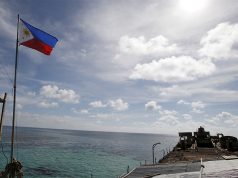
- Coral reefs in South China Sea hurt by politics
- Philippines to sue China for environmental damages
- Forget the blame game, scientists urge cooperation
MANILA (Thomson Reuters Foundation) — Territorial wrangling over who owns the South China Sea has strangled local marine life, say scientists, urging China and the Philippines to set aside political differences and work to save the fish, coral and plants that live border-free.
A tug of war over the sea – spanning more than 3.5 million square km – has divided the two nations for over two decades, a standoff built on deep history and modern economics.
Based on its reading of old maps, China claims almost the entire South China Sea as its own, including the Scarborough Shoal, famed for its rich fish stocks and exquisite lagoon.
The shoal sits 200 km off the Philippines and jostling over its ownership is just one flank in a long series of air and sea encounters between the two countries.
For their part, marine biologists from the Philippines point to an unintended environmental casualty of all the wrangling, saying geopolitics and money now jeopardize one of the world’s most precious marine ecosystems.
“Amid this geopolitical tension that we have in the region are the corals, the fishes, the invertebrates, and the organisms that are not privy to the politics,” Deo Onda, a professor at the University of the Philippines Marine Science institute (UP MSI), said during a forum in July.
“As we always say, fishes do not have passports.”
Filipino marine scientists say that the installation of new islands by China has destroyed more than 4,000 acres of coral reef, with a further 16,000 acres of coral damaged by mass clam harvesting – economic endeavors that at the same time massively depleted the fish population.
Fishing vessels have also struggled to enter the disputed areas, they said.
The Philippines and China have long lobbed environmental accusations back and forth, even as they sealed a provisional arrangement in July aimed at de-escalating the conflict.
In May, the Philippine government said it would sue China for environmental damage in the West Philippine Sea (WPS)— as it calls its territories in the South China Sea — eight years after an international ruling upheld the Philippines’ sovereign rights on its claimed areas.
China claims sovereignty over most of the South China Sea, overlapping into the maritime zones of Brunei, Indonesia, Malaysia, the Philippines and Vietnam.
A 2016 ruling in the Hague voided China’s sweeping claims, a victory for the Philippines.
Beijing refuses to recognize the tribunal ruling.
China, in turn, says a dilapidated Philippine warship that ran aground had destroyed coral reefs, a claim denied by Manila.
But for all the finger pointing, marine experts have urged both sides to move beyond politics and cooperate on environmental protection and conservation.
“If we want to solve the problems in the West Philippine Sea, we need to start in our own backyard, but we need to really work with our neighbors,” said Onda.
“And isolating or excluding China from the conversation is not an option.”
Beyond recovery
Coastal and marine geologist Fernando Siringan, also from UP MSI, said the environmental fallout from politics was exacerbated by years of economic exploitation by China.
“Reclaiming portions of the sea to build islands has direct damages to coral reefs,” Siringan told the Thomson Reuters Foundation. “China’s island building was massive.”
Since 2013, China has built artificial islands that cover more than 3,000 acres of the Spratlys, according to U.S.-based policy organisation Asia Maritime Transparency Initiative.
Siringan said building artificial islands not only killed coral reefs beyond recovery but also wreaked massive damage on atolls that can help heal coral reef life.
Coral reefs are key for healthy marine life – protecting coastlines from storms or erosion and supporting fisheries.
The Philippines claims Scarborough Shoal and the northeastern section of the Spratly Islands as the Kalayaan Island Group, home to more than 3,000 square km of coral reef or more than a third of the nation’s entire stock.
A study last December by the Asia Maritime Transparency Initiative also blamed China’s dredging and clam harvesting for destroying almost 20,000 acres of reefs in the South China Sea.
“We must go back to these issues. We need to account them as direct damages,” said Siringan.
Conflict had also reduced the fish catch, scientists say.
The WPS is a traditional fishing ground with high yields, said marine science professor Charina Repollo.
The area is also home to 65% of the country’s seaweed, including a new species that produces an anti-HIV compound.
But Repollo, the marine scientist, said studies show a 70% drop in the overall number of fish and the loss of one in every two types of fish in the disputed area over the last 30 years.
What data?
Key to preserving the environment is accurately assessing the damage that has been done, Repollo said, urging more expert surveys of off-shore reefs.
But a funding shortfall, along with interference by Chinese vessels, often get in the way, she said.
“One way to assert our sovereignty in this area is to have (a) presence and to have activities, especially marine scientific research,” said Repollo.
Setting aside the dispute with China, Siringan said the government must better support science in the sea.
“We desire regular funding,” said the marine scientist. “It’s a huge area, and we can work together to survey the sea.
Wilfredo Licuanan, who has monitored coral reefs for over 25 years, said the Philippines lacks a mechanism for the long-term monitoring of its reef systems.
This may mean imprecise measurements and surveys, especially in areas the Philippines can no longer access, said Licuanan.
Scientists believe Southeast Asian countries must share scientific data to help de-escalate longstanding conflicts.
A recent joint drill between the Philippine and Vietnamese coastguards, both of which have territorial claims in the waters, renewed interest in regional maritime cooperation.
“At the end of the day, it always boils down to the fact that marine environments do not have boundaries,” said Onda. “We need to think… how we can move forward with marine scientific cooperation… as a potential science diplomacy avenue.”
— Reporting by Mariejo Ramos. Editing by Lyndsay Griffiths









